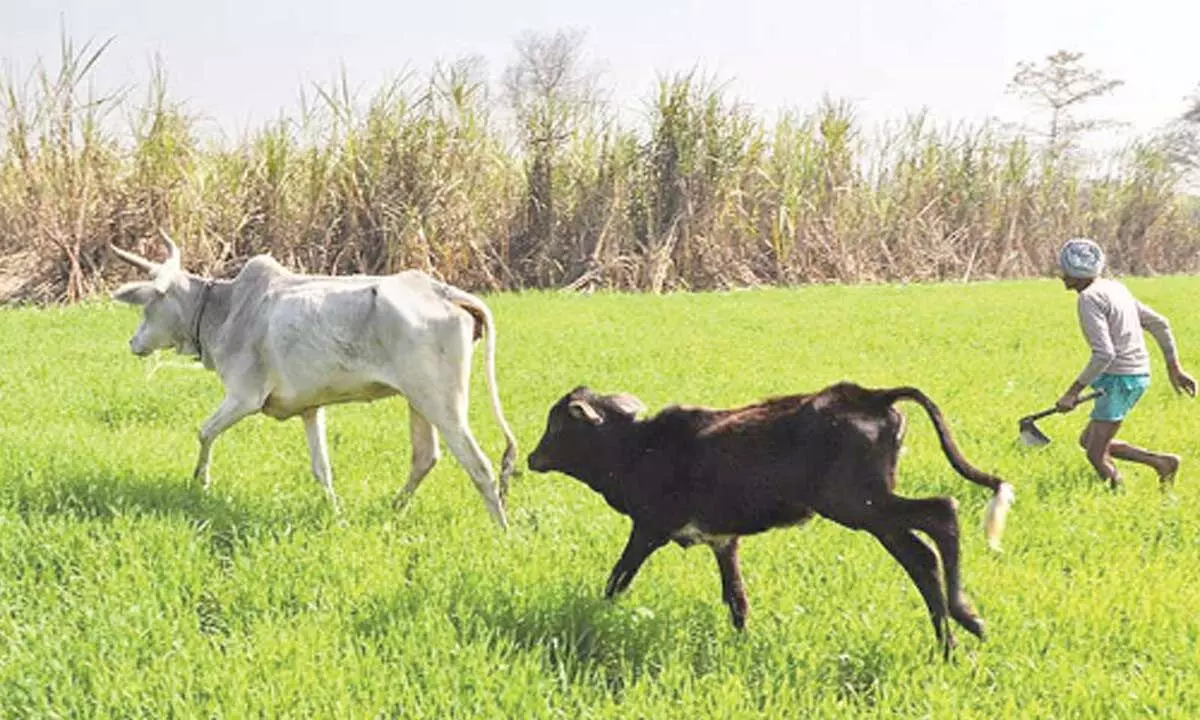Stray cattle menace key poll issue for farmers in western UP

“WhenI come to work in the fields in the morning, stray cattle are standing there, ready to attack. I was once hit on the back and was hospitalised for a week,” says Keshav Kumar, a farm worker in Pilkhana village in Uttar Pradesh’s Hathras.
Hathras/Firozabad: “WhenI come to work in the fields in the morning, stray cattle are standing there, ready to attack. I was once hit on the back and was hospitalised for a week,” says Keshav Kumar, a farm worker in Pilkhana village in Uttar Pradesh’s Hathras.
Besides, he said, he has been chased by cows and Nilgai multiple times. Dharmendra Singh, a farmer, in Firozabad’s Akilabad village, says, “I lost 30 per cent of my produce due to stray cattle entering my field. There is drought, unseasonal rain and now this stray cattle menace. What are we supposed to do?”
Instances like these are not uncommon in western Uttar Pradesh and encapsulate the stray cattle menace that farmers have been struggling with for several years now.
The problem, exacerbated by recent policy changes, has emerged as a major issue in western Uttar Pradesh in the ongoing Lok Sabha elections. The importance of the issue can be gauged from the fact that it is the sole deciding factor for some.
“I voted for ‘phool’ (referring to the BJP’s party symbol lotus) in the last two general elections thinking that this problem would be solved. As the problem remained unresolved, I didn’t vote for them in the assembly polls and plan to vote for the SP this time,” Kumar said.
In villages across western Uttar Pradesh, the sight of emaciated stray cattle roaming around has become all too common and so is the sight of destroyed crops. When they can’t enter fields, many cows feed on plastic and garbage.
Farmers are also upset over the state government’s decision to reinforce an old order that no barbed wires should be used to fence fields. Now, most farmers use plain wires or saris and dupattas to fence fields.
“They are of no use. We don’t understand why the government cannot understand our losses,” said Akilabad farmer Singh.
According to the 2019 Livestock Census, there are over 1.90 crore cattle in Uttar Pradesh, including 62,04,304 milch cows and 23,36,151 dry cows. The indigenous female cattle population increased by 10 per cent in 2019 compared to the previous census in 2012. The population of exotic and cross-bred cattle increased by 26.9 per cent from 2012 to 2019.
The stray cattle menace has also added to farmers’ economic woes as they do not know what to do with cows that have stopped giving milk. “Earlier, we would give the old cow in exchange for 10-20 per cent of the down payment and get a new one. But with the new policy, even that is not possible. We have no option but to either sell them illegally or abandon them,” said a farmer who did not wish to be named.
In May 2017, the Centre banned the sale of cattle for slaughter in animal markets across the country. The environment ministry notified the stringent ‘Prevention of Cruelty to Animals (Regulation of Livestock Markets) Rules, 2017’ under the Prevention of Cruelty to Animals Act.
Every village in western Uttar Pradesh has a cow shelter but they are at capacity. PTI visited five cow shelters in the region and they were all at capacity. “In big cow shelters, we can accommodate up to 115 cows and as you can see, we are full,” a cow shelter worker told PTI on the condition of anonymity. He said shelters receive meagre amounts from the government to take care of the cows.
“Last year, I received Rs 6,000 for feeding them. How do we feed them with that amount?” he said. Chaudhary Pushpendra Singh, the president of farmers’ organisation Kisan Shakti Sangh, stressed the importance of adopting sustainable solutions, such as setting up more cow shelters, promoting livestock insurance schemes and incentivising responsible cattle rearing practices, to tackle the stray cattle crisis. This region is a potato belt, a crop that cows often eat. Though they do not consume wheat, they ruin the crop while passing through the fields, he said.
Amid the election fervour, this issue stands as a potent symbol of the broader challenges faced by rural India, he said, underscoring the critical need for proactive governance and sustainable development strategies.
As polling day approaches, voters in western Uttar Pradesh are keenly watching how various candidates in the fray propose to address the stray cattle menace. So far, they do not have much to look forward to with political parties keeping mum on the issue. A Samajwadi Party (SP) functionary told PTI that the issue of stray cattle menace is very sensitive.
“It is a major issue here and if we come to power, we will look into it very seriously,” he said. Hathras and Firozabad go to polls in the third round of the seven-phase Lok Sabha elections on May 7.
The two constituencies will see a direct fight between the ruling BJP and the SP. In Hathras, Uttar Pradesh minister and BJP candidate Anoop Pradhan Balmiki will take on SP’s Jasveer Valmiki. In Firozabad, BJP’s Vishwadeep Singh is pitted against SP chief Akhilesh Yadav’s cousin Akshay Yadav.









